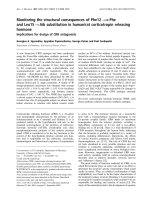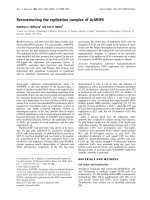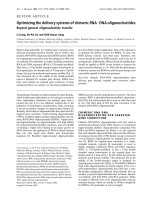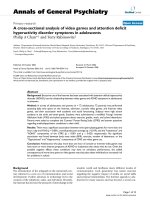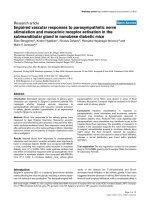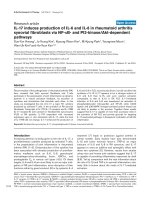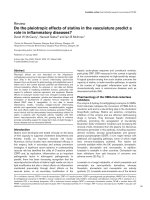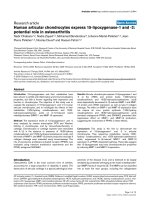Báo cáo Y học: Monitoring the structural consequences of Phe12 fi D-Phe and Leu15 fi Aib substitution in human/rat corticotropin releasing hormone Implications for design of CRH antagonists pdf
Bạn đang xem bản rút gọn của tài liệu. Xem và tải ngay bản đầy đủ của tài liệu tại đây (445.79 KB, 11 trang )
Monitoring the structural consequences of Phe12 fi
D
-Phe
and Leu15 fi Aib substitution in human/rat corticotropin releasing
hormone
Implications for design of CRH antagonists
Georgios A. Spyroulias, Spyridon Papazacharias, George Pairas and Paul Cordopatis
Department of Pharmacy, University of Patras, Greece
A new human/rat CRH analogue has been synthesized
using the Fmoc/tBu solid-phase synthetic protocol. The
sequence of the new peptide differs from the original in
two positions, 12 and 15, at which the native amino acids
L
-phenylalanine 12 and
L
-leucine 15 have been replaced
by the nonprotein amino acids
D
-phenylalanine and
a-aminoisobutyric acid (Aib), respectively. The high
resolution three-dimensional solution structure of
[
D
-Phe12, Aib15]CRH has been determined by 688 dis-
tance constraints (656 meaningful NOE and 32 H-bonds
distance limits) and 21 angle constraints. A family of 40
energy-minimized conformers was obtained with average
rmsd of 0.39 ± 0.16 A
˚
and 0.99 ± 0.13 A
˚
for backbone
and heavy atoms, respectively, and distance penalty
functions of 0.42 ± 0.03 A
˚
2
. The NMR data acquired in
a solvent system of water/trifluoroethanol (34%/66%, v/v)
revealed that this 41-polypeptide adopts an almost linear
helical structure in solution with helical content which
reaches an 84% of the residues. Structural analysis con-
firmed the existence of two helical peptide fragments. The
first was comprised of residues Ile6–Arg16 and the second
of residues Glu20–Ile40, forming an angle of 34.2°.The
structural differences with respect to the native peptide
have been identified in the region
D
-Phe12–Glu20 where
double substitution at positions 12 and 15 seems to per-
turb the elements of the native 35-residue helix. These
structural rearrangements promote non-native intramo-
lecular interactions in the region of the molecule between
either the hydrophobic side-chains of
D
-Phe12, Aib15 and
Leu18, or the charged groups of the residue pairs Arg16–
Glu20 and His13–Glu17 being responsible for changes in
hormonal functionality. This CRH analogue currently
exhibits lack of any activity.
Keywords: corticotropin releasing hormone; NMR; solid
phase synthesis; solution structure; synthetic analogue.
Corticotropin releasing hormone (CRH) is a 41-amino
acid neuropeptide characterized by the presence of an
isoleucine-amide in its C-terminal end (Scheme 1). It is
produced mainly in the hypothalamus and acts as the
principal neuroregulator of the secretion of adrenocor-
ticotropic hormone (ACTH), b-endorphin and other
proopiomelanocortin products of the anterior pituitary
gland. CRH is considered to be the key hormone in the
control of the hypothalamic–pituitary–adrenal axis func-
tion and is responsible for the endocrine, autonomic,
immunological and behavioural responses of mammalians
to stress [1–3]. The hormone interacts at a nanomolar
level with a transmembrane receptor belonging to the
Gs-protein coupled family. CRH binds to membrane
homogenates from the anterior pituitary, revealing a
high-affinity component of 0.1 n
M
and a low-affinity
binding site at 20 n
M
[4]. There is a wide distribution of
CRH receptors throughout the human body, indicating
that the hormone is probably implicated in a variety of
actions, including inflammatory phenomena, the effects
of various stressors, pregnancy and labour, food intake,
thermoregulation, etc. [5–11]. The role of CRH has not
yet been elucidated in every possible situation and new
evidence is constantly appearing, establishing an even
more complicated involvement in many biological func-
tions. Moreover, inappropriate or disturbed CRH neur-
onal activity manifests itself in various neuropsychiatric
disorders such as affective disorders, anorexia nervosa
and Alzheimer’s disease [12].
The great variety of functions mediated by CRH, or in
which the hormone plays an active role, led to an effort to
determine the structure–activity relationships which could
clarify its action. Thus, an a-helical conformation of high
amphiphilicity was found to be the major characteristic of
the molecule’s tertiary structure. Residues 4–8 were found to
be essential for receptor recognition, while residues 9–41 are
responsible for binding and exertion of action [13]. The
study of this molecule has led to the development of agonists
Correspondence to P. Cordopatis, Department of Pharmacy,
University of Patras, GR-265 04, Greece.
Fax: + 30 2610997 714, Tel.: + 30 2610997 713,
E-mail:
Abbreviations: CRH, corticotropin releasing hormone; Aib,
a-aminoisobutyric acid; TFE, 2,2,2-trifluoroethanol; DQF-COSY,
Double-quantum-filtered phase sensitive correlated spectroscopy;
WATERGATE, water suppression by gradient-tailored excitation;
REM, restrained energy minimization.
Note: atomic coordinates of the 40 best and the mean energy mini-
mized structures have been deposited in the Protein Data Bank
(accession codes 1goe and 1go9, respectively).
Note: a web site is available at
(Received 22 July 2002, accepted 13 September 2002)
Eur. J. Biochem. 269, 6009–6019 (2002) Ó FEBS 2002 doi:10.1046/j.1432-1033.2002.03278.x
and antagonists of CRH, which can be either peptidic or
nonpeptidic. These analogues have the potential to be
pharmacological tools for intervention in pathological
conditions such as Cushing’s syndrome, inflammatory dis-
eases, pre-eclampsia or preterm labour, anxiety and depres-
sion and a potentially great number of other disorders.
We have previously described the synthesis and the
biological evaluation of a new series of CRH analogues,
which showed that most analogues tested were deprived of
any significant agonist effects [14]. These findings prompted
us to study the conformational features of the analogue
[
D
-Phe12, Aib15]CRH through one- and two-dimensional
J-correlated
1
H NMR spectroscopy. Structure calculations
were performed using simulated annealing protocols and
restrained energy minimization (REM). Structural charac-
teristics imposed by the introduction of the novel residues
in the sequence of the molecule and the differences between
the CRH analogue and the native structure [15] are also
discussed.
The major goal of our study is the solution structure
determination of a CRH analogue devoid of any agonist
activity, a fact particularly relevant to the further design and
development of CRH antagonists with wide-ranging clinical
applications in psychiatric disorders.
MATERIALS AND METHODS
Sample preparation
The CRH analogue was synthesized using Fmoc/tBu
chemistry by solid-phase peptide synthesis and was purified
and characterized via reversed phase HPLC and ESI-MS
[14]. The CRH analogue was dissolved to a final concen-
tration of 2–2.5 m
M
in H
2
O/2,2,2-trifluoroethanol (TFE)-d
2
(CORTEC, Paris, France; 34%/66%, v/v) to record one-
and two-dimensional NMR spectra, and the pH was
adjusted to 3.8. For amide exchange experiments, the
peptide was lyophilized and dissolved in D
2
O/TFE-d
3
(34%/66%, v/v).
NMR spectroscopy
NMR spectra were recorded on Bruker’s 500 and 600-MHz
spectrometers in 298K and 310K. One- and two-dimen-
sional double-quantum-filtered-COSY [16], TOCSY [17,18]
and time-proportional phase incrementation-NOESY
[19,20] spectra were acquired in the 10–14 p.p.m. spectrum
window using PRESATURATION [21] and WATER-
GATE [22] pulse sequences for H
2
O suppression. Spectra
were calibrated according to the characteristic methylene
resonance of TFE-d
2
at 3.926 p.p.m. TOCSY experiments
were carried out with a mixing time of 80–100 ms, whereas
NOESY experiments were recorded using 100 and 200 ms
mixing times. All two-dimensional spectra were acquired
using a spectral width of 6410.26 Hz (10.7 p.p.m) and
consisted of 2048 data points in the F2 dimension, 16–32
transients and 720–1024 complex increments in the F1
dimension. Raw data were multiplied in both dimensions by
a pure cosine-squared bell window function and Fourier-
transformed to obtain 2048 · 1024 or 2048 · 2048 real data
points. A polynomial base-line correction was applied in
both directions.
NMR data processing was performed using the
standard Bruker software package on a Silicon Graphics
O2 workstation. The two-dimensional maps were ana-
lysed on Silicon Graphics O2 or PentiumIII PC-Linux
computers with the aid of the
XEASY
program (ETH,
Zu
¨
rich) [23].
NOE constraints,
3
J
HNHa
and C
a
H chemical shift analysis
A total of 1868 NOESY cross-peaks were assigned in both
dimensions and their intensities were converted into upper
limits of interatomic distances [24], yielding 928 unique
NOE constraints (23.1 per assigned residue).
3
J
HNHa
were determined using the Protocol 1 of
D. S. Wishart et al. [25]. Twenty-one out of 28 measured
3
J were calculated in the range of 4.8–5.6 Hz or > 8.0 Hz
[26] and introduced to the calculations. Seven
3
J
HNHa
were
found in the range 6–7 Hz and were not used in structural
calculations [27].
Slowly exchanging amides were identified using the
lyophilized original sample in D
2
O/TFE-d
3
solution,
through two-dimensional NOESY spectra over a time
period of 4–5 h.
Chemical shift analysis was performed according to the
approach established by Wishart et al. [28,29] and shift
differences between the H
a
-protons of the human/rat CRH
analogue and their values for coil conformation were
extracted. No correction for the solvent was applied to the
initial C
a
H shifts values drawn from the TOCSY/NOESY
maps [30].
Structure calculations and refinement
Structure was calculated using the NMR data acquired at
310 K, the temperature at which native human/rat CRH
solution structure was also determined. Of 928 constraints,
656 were found meaningful (16.4 per assigned residue) in
DYANA
structural calculations [31]. Appropriate pseudo-
atom corrections were applied to methylene and methyl
hydrogens that were not stereospecifically assigned [32].
a-Aminoisobutyrilo (Aib) residue is derived from a valine
where the C
a
of the Aib corresponds to valine C
a
and
C
b1
/C
b2
of the Aib corresponds to valine C
c1
/C
c2
.
Sixteen hydrogen bonds involving nonexchangeable
H
N
amide protons, with an occurrence of 87.5% (in 35
out of 40 structures), were used as additional structural
constraints in the final stage of
DYANA
calculation.
Upper (2.40 A
˚
) distance limits between H
N
and O atoms
involved in hydrogen bonds, together with upper
(3.30 A
˚
) and lower (2.60 A
˚
) distance limits between the
corresponding N and O atoms, were set for each one of
the 16 hydrogen bonds. Fourteen pairs of diastereotopic
protons (among them the two methyls of Aib15) were
stereospecifically assigned through the
GLOMSA
program
[24].
Each one of the 40 best structures (out of 400 calculated)
in terms of
DYANA
target function (larger NOE constraint
Scheme 1. Primary structure of various natural CRH peptides.
6010 G. A. Spyroulias et al. (Eur. J. Biochem. 269) Ó FEBS 2002
violation 0.09 A
˚
) has been refined through REM (
AMBER
5.0 [33],
SANDER
[34]). The whole procedure followed
protocols previously applied to the solution structure
determination of larger biomolecules, such as metallopro-
teins [35]. A force constant of 133.76 kJÆmol
)1
A
˚
2
was
applied for the distance constraints.
Structural calculations were performed on IBM RISC
6000 or PentiumIII PC-Linux computers.
Quality assessment of the structure
PROCHECK
[36] and
PROCHECK
-NMR [37] programs were
used to check the stereochemical quality of the peptide
structure and provide the elements of the secondary
structure, as well as other statistical parameters.
RESULTS
NMR spectra–proton assignment
The spin patterns of 39 out of 41 residues have been
identified through analysis of the TOCSY spectrum (Fig. 1),
whereas Ser1 and Leu27 proton resonances have not been
assigned at this stage. The latter have been identified in
NOESY maps recorded at two different temperatures due
to their sequential dipolar connectivities while the former
have remained undetectable in all two-dimensional maps
at both temperatures. Proton chemical shifts are given in
Table S1.
Secondary structure
Fig. 2A shows the short and medium range NOEs observed
for the backbone and C
a
H protons. Sequential H
N
–H
N
connectivities for stretches up to two amino acids were
observed for residues 6–13, 14–19, 20–28, 29–31, and 31–40.
H
N
–H
N
connectivities involving the H
N
resonances of Ser7/
Thr11, Phe12/Leu14, Val18/Met21, Leu19/Glu20 and
Gln26/Ala28/Gln30, could not be detected due to their
degenerated shifts. The same is true of some H
a
–H
N
medium-range connectivities, where the H
a
resonances of
Ala28/Gln29 and Arg35/Lys36 have degenerated chemical
shifts.
Eighteen
3
J
HNHa
(Fig. 2B, upper panel) were found to
be £ 5.6 Hz while three (Glu2, Glu3 and Val18) were
found to be in the range 8.0–8.5 Hz.
3
J
HNHa
for
D
-Phe12
was found 6.9 Hz and six (Leu10, Thr11, Leu19, Gln26,
Ile39 and Ile40) exhibited values in the range 6.0–6.6 Hz.
Chemical shift difference analysis between the observed
C
a
H shift values and the corresponding random coil
values is presented in Fig. 2B (lower panel) and provides
strong evidence for the conformational preference of the
majority of amino acids towards the helical configur-
ation. The only tetrapeptide in which H
a
values present
large positive differences from random coil values is
the N-terminal Glu2-Pro5/Ile6 region (Ile6 Dd H
a
0.06 p.p.m). A three-residue fragment, Ala31–Asn34,
exhibited slightly positive shift differences (in the range
Dd H
a
0.009–0.045 p.p.m) while the remaining 32 res-
idues in the region Ser7–Ile41 exhibited negative H
a
shift
differences in the range 0.011–0.524 p.p.m. According to
data reported previously the conformation of that
fragment seems to be different in ovine and human
CRH, and for this reason its structure has been discussed
in the literature [38] (Scheme 1). However, despite the
positive H
a
shift difference, Ala31–Asn34 H
a
chemical
shift values compared with the averaged H
a
shifts for
helical and b-sheet conformation [28] and they exhibited
a smaller deviation from a-helical rather than b-strand
values (see Fig. 2C).
Tertiary structure
An overall evaluation of NOE,
3
J
HNHa
and H
a
chemical
shifts suggests a helical conformation for the peptide
fragment Ile6–Ile40 and an extended structure for the
N-terminal hexapeptide. Structure was calculated using
NMR data acquired at 310 K (as in native CRH [15]). The
resulting
DYANA
family of 40 structures has rmsd values
(calculated for residues 6–41) of 0.56 ± 0.24 A
˚
and
1.40 ± 0.20 A
˚
for backbone and heavy atoms, respectively.
The target function lies in the range 0.10–0.12 A
˚
2
. The final
REM family exhibits pair-wise rmsd values of
0.56 ± 0.23 A
˚
(backbone), 1.42 ± 0.19 A
˚
(heavy atoms)
for the 40 structures and 0.39 ± 0.16 A
˚
(backbone),
0.99 ± 0.13 A
˚
(heavy atoms) for the mean structure. The
NOE distance penalty function for the family of 40
structures is 0.42 ± 0.03 A
˚
2
and 0.44 A
˚
2
for the mean
structure. The corresponding values for H-bond and angle
constraints are 0.016 ± 0.01 A
˚
2
(40 structures), 0.012 A
˚
2
(mean) and 0.014 ± 0.006 A
˚
2
(40 structures), 0.005 A
˚
2
(mean), respectively (see also Table 1) and in both cases the
Fig. 1.
1
H-
1
H two-dimensional TOCSY 600-
MHz NMR of the fingerprint region of H
a
–H
N
protons recorded on a 10.7-p.p.m. spectrum
width (H
2
O/TFE-d
2
34%/66% v/v, at
pH = 3.8, T =310K).The number of the
aminoacidintheCRHsequence,towhichthe
H
a
–H
N
connectivity belongs, is noted.
Ó FEBS 2002 NMR structure of a CRH synthetic analogue in TFE/H
2
O(Eur. J. Biochem. 269) 6011
penalty function is around 30 times smaller than that of
NOEs. The NOE-derived distance constraints are reported
in Fig. 2D while rmsd per residue for the final family is
given in Fig. S1. Fig. 3A shows the family of 40 structures
and Table 1 contains a summary of statistical data indica-
ting the quality of the 40 models and the average energy-
minimized structure.
The polypeptide chain of the human/rat CRH analogue
seems to fold to an almost linear tertiary structure with the
main features being the high degree of helical character and
a small bend along the principal molecular axis. As far as
the ill-defined N terminus is concerned, all data (chemical
shift index,
3
J
HNHa
,andu vs. w plots, Fig. S2) imply a
conformational preference for an extended structure. The
unambiguous conformational preference for helical struc-
ture for the C-terminal 10-peptide is manifested by numer-
ous helix-diagnostic NOEs (see also Fig. 2A), and the
3
J
HNHa
values. Strong evidence for the Glu39–Ile41 tripep-
tide’s compact structure was obtained from the intense
NOESY peaks of the two –CONH
2
amide protons which,
in turn, give rise to a network of H
N
–H
N
cross-peaks
throughout in this region. The numerous O
i
H
N
i þ 4
type
H-bonds identified after the final
DYANA
calculation (Ala28
O¢–H
N
His32, Gln29 O¢–H
N
Ser33, His32 O¢–H
N
Lys36,
Ser33 O¢–H
N
Leu37, and Arg35 O¢–H
N
Glu39in40out
of 40
DYANA
models) further support the continuous
C-terminal helix structure.
Monitoring the Phe12 fi D-Phe and Leu15 fi Aib
substitution
The NOE pattern of the CRH analogue involving H
N
,H
a
and H
b
protons of
D
-Phe12, was constituted only by
d
NN
(i,i +2)andd
aN
(i,i + 2) connectivities, while connec-
tivities diagnostic for a-helix such as d
aN
(i,i +3),
d
ab
(i,i +3)andd
aN
(i,i + 2) were not observed (Fig. 2A).
The Aib15 residue possesses two diastereotopic methyl
groups, with the pro-R methyl replacing the H
a
proton at
C
a
carbon of an
L
-valine and the pro-S group corresponding
to the side chain (C
b
of an
L
-valine). The protons of the two
C
b
H
3
groups were found to be chemically and magnetically
nonequivalent and to yield two different resonances in the
region 1.70–1.90 p.p.m. Moreover, the stereospecific assign-
ment of these methyl groups was achieved through analysis
of the observed spin couplings and the intensities of
d
bN
(i,i +1),d
bN
(i,i +2) and d
bN
(i,i + 3) NOEs. Thus,
the C
b1
methyl group which resonates at 1.861 p.p.m. is
assigned to the pro-S because it exhibits NOEs of low
intensity in respect with C
b2
(1.716 p.p.m) methyl, of the
type d
bN
(i,i +2)andd
bN
(i,i +3)[39].
Fig. 2. Analysis of NMR-derived data. (A)
Schematic representation of the sequential and
medium-range NOE connectivities involving
NH, a-andb-protons. The thickness of the
bar indicates the intensity of NOEs. The
average, over the 40
DYANA
structures,
secondary structure elements are also
reported. (B) Measured values of
3
J
HNHa
coupling constants in Hz (upper panel) and
H
a
chemical shift differences from random coil
values (lower panel). (C) Comparison of H
a
chemical shift values of [
D
-Phe12, Aib15]CRH
with the corresponding H
a
chemical shifts for
helical (
)andb-strand (m) configurations.
(D) Number of meaningful NOE constraints
per residue for [
D
-Phe12, Aib15]CRH used in
the structural calculations. White, grey, and
dark grey bars represent, respectively,
intraresidue, sequential, and medium-range
connectivities. Long-range connectivities were
not observed.
6012 G. A. Spyroulias et al. (Eur. J. Biochem. 269) Ó FEBS 2002
Distribution of electrostatic charges on the surface
and along the principal axis of the molecule
In the synthetic CRH analogue, as in native peptide, there
are seven negatively charged (six Glu and one Asp) and four
positively charged residues. Analysis of the distribution of
the electrostatic potential on the surface of the molecule
reveals the ampiphilic character of the helix (Fig. 4A).
Schematic representation of the charge distribution along
and perpendicularly to the [
D
-Phe12, Aib15]CRH axis is
presented at Fig. 4B and C. Non-native interaction between
charged groups in this synthetic analogue is discussed
below.
DISCUSSION
Analysis of the calculated structures performed by the
PROCHECK
program provides quality data for the calculated
CRH models (Table 1). Neither the 40 models nor the mean
structure possess a residue in disallowed regions of Rama-
chandran plot (Table 1 and Fig. S2).
According to the
PROCHECK
-NMR [37] program, the
average of the 40 models and the mean minimized structure
of the synthetic analogue [
D
-Phe12, Aib15]CRH, contain up
to 84% helical structure. This value is either somewhat
larger than that of the 76–78% regarding the helicity of the
native peptide in solution containing 66–100% of TFE
[15,40], or identical to the 84% for studies carried out in
40% TFE in an H
2
O mixture [38]. According to studies of
CRH binding to single bilayer egg phosphatidylcholine
vesicles, the development of the intramolecular interaction
with the cell membrane is accompanied by the induction of
a a-helical structure and this conformation characterizes the
biologically active form of the peptide [41]. TFE assists
amphipathic peptides with high helical propensity, such as
CRH, to reach the maximum helical content at around 40%
TFE [42], since it diminishes the exposure of CO and NH
groups in the solvent [43], favouring hydrogen bond
formation [44]. This apparently occurred in the case of the
currently studied CRH molecule and the same has been
reported earlier for ovine and human/rat-CRH [38,41].
In calculated models, the CRH a-helix consists of 34
residues in regions 6–18 and 20–40 and this is fully consistent
with the diagram of sequential dipolar connectivities
(Fig. 2A), the
3
JsandO
i
H
N
i þ 4
type H-bonds. The structure
of the Gln30–Ile40 fragment has been determined with
high resolution and exhibits remarkably low rmsd values
(0.28–0.54 A
˚
). These data: (a) suggest a conformational
difference with the structureless C terminus of ovine CRH
[38] and (b) contradict the helix-stop signal identified for the
native human/rat CRH in the residue fragment 31–34 and
the ill-defined terminal pentapeptide 37–41 [15,38].
Leu19 interrupts the helical structure in all structures
composing the family of 40 models and also in the mean
Fig. 2. (Continued).
Ó FEBS 2002 NMR structure of a CRH synthetic analogue in TFE/H
2
O(Eur. J. Biochem. 269) 6013
structure. However, in various
DYANA
models, helical
structure is also interrupted for two up to five residues in
the 6/9–13/15 region. Destabilization of the helix in
fragment 9–13 could be discussed in terms of the
introduction of a
D
-amino acid at position 12 [45].
Destabilization caused by
D
-amino acid depends on the
nature of its side chain (charged or not, bulky or not) and
D
-phenylalanine has been found to present one of the
highest a-helix disturbing propensities [46]. Loss of NOEs
between
D
-Phe and sequential residues in the CRH
analogue was observed as in a similar kind of
L
-/
D
-amino
acid substitution [45,46], and suggests slight helix destabil-
ization in the region of Leu10, Thr11 and
D
-Phe12. For
this fragment, experimental coupling constant values are
measured between 6 and 7 Hz (Fig. 2B), suggesting
conformational averaging over the contributing conforma-
tions [27].
On the other hand, the helix-promoter/stabilizer Aib,
which replaced Leu15, increases the helix propensity of a
peptide fragment towards either a-or3
10
-helix by restriction
of the backbone conformational freedom [47–49]. This
limitation is imposed by the steric hindrance that arises from
its gem-dimethyl group. The torsion angles for the main-
chain conformation of Aib15 in the family of 40 energy
minimized structures are calculated as u ¼ )59.6° ±1.5
and w ¼ )31.9 ± 1.5, while for the mean energy minimized
structure they are )56.5° and )31.0°, respectively, close to
those of Aib conformational energy minima (u ¼ ) 58° and
w ¼ )34° [50]). According to these values, the Aib u torsion
angle deviates less from a-thanfrom3
10
-helix typical values
()55.2° and )49.9°, respectively [48]) while the w torsion
angle is practically the same as the ideal w-value ()34°)for
3
10
helical configurations ()52.2° for a- helix [48]). As far as
the surrounding amino acids in the His13–Glu17 fragment
are concerned, His13 and Glu17 w angles are found slightly
out of the range of values for a-helix structure, while w
angles for Leu14 and Arg16 are considerably close to the
range of values for 3
10
helix. Additionally, Leu14 possess a u
torsion angle almost typical for the 3
10
helix.
In this region of the polypeptide chain, the secondary
structure is characterized also by the O
i
H
N
i þ 3
hydrogen
bonds, found in all 40
DYANA
structures in His13–Arg16
and Leu14–Glu17, which are indicative of a 3
10
-, rather than
a pure a-helical structure. Nevertheless, H-bonds O
i
H
N
i þ 4
,
typical in a-helices, are also observed in Leu14–Val18 and
Aib15–Leu19.
All of the above data imply that the His13–Leu19
backbone structure is probably a conformational average
bearing features of a pure a-helix and 3
10
-helix structure.
This is in agreement with the ÔambihelicityÕ behaviour
pattern stated by Basu et al. [51,52] according to which the
a-and3
10
-helical forms are almost equivalent energetically
when only one or two Aib residues replace other amino
acids in a peptide sequence.
Furthermore, a noticeable feature of the [
D
-Phe12,
Aib15]CRH molecule is a characteristic bend occurring
Table 1. Statistical analysis for the REM
a
and ÆREMæ
a
structures of [
D
-Phe12, Aib15]CRH.
REM ÆREMæ
RMS violations per experimental distance constraints (A
˚
)
b
Intraresidue (229) 0.0184 ± 0.0015 0.0173
Sequential (193) 0.0195 ± 0.0017 0.0192
Medium-range (234) 0.0274 ± 0.0017 0.0313
Long-range (0) 0.0000 ± 0.0000 0.0000
Total (656) 0.0224 ± 0.0011 0.0235
Mean number of violations per structure
Intraresidue 9.78 ± 1.56 9.0
Sequential 10.18 ± 1.53 10.0
Medium-range 14.65 ± 2.01 18.0
Long-range 00.00 ± 0.00 00.0
Total 34.60 ± 2.80 37.0
Mean no. of NOE violations > 0.3 A
˚
0.000 ± 0.00 00.0
Largest residual NOE distance violation (A
˚
) 0.245 0.222
Mean distance penalty function (A
˚
2
) 0.400 ± 0.03 0.440
Statistics of other structural constraints
H-bond constraints
c
(32)
Mean distance penalty function (A
˚
2
) 0.016 ± 0.010 0.012
/ Constraints from
3
J
HNHa
(21)
Average torsion penalty function (kJÆmol
)1
) 0.014 ± 0.006 0.005
AMBER energy (kJÆmol
)1
) )1706.70 ± 111.6 )1768.52
Structural analysis
Residues in disallowed regions (%) 0.0 0.0
Residues in generously allowed regions (%) 0.2 0.0
Residues in allowed regions (%) 9.4 13.5
Residues in most favorable regions (%) 90.4 86.5
Overall G-factor )0.16 ± 0.04 )0.11
a
REM indicates the energy-minimized family of 40 structures and ÆREMæ the mean energy-minimized structure.
b
Numbers in parenthesis
indicate the number of meaningful upper distance limits per class.
c
Two distance limits per each H-bond constraint (see Materials and
methods).
6014 G. A. Spyroulias et al. (Eur. J. Biochem. 269) Ó FEBS 2002
in the 12–16 region which is a striking difference from the
native CRH molecule. This feature is apparently related to
the contemporary incorporation of a
D
-andana,a-
dialkylo amino acid in close proximity within the CRH
sequence. Besides its tendency to form constrained helices,
Aib is also known for its ability to bend helical peptides
[53]. Analogous helical structure perturbation has been
observed where either a sequential double replacement of
D
-amino acid [46] or a double incorporation of Aib residue
in a tripeptide fragment [53] has been carried out. These
features in the CRH analogue are supported by numerous,
well-defined NOE cross-peaks between the side-chains of
the residues in the 12–22 region (see Fig. 3B). H
a
,H
b
and
C
c2
methyl protons of Thr11 give rise to NOE interactions
with Aib15 methyls while a NOE signal was also observed
between Thr11 C
c2
methyl and Aib15 H
N
proton. Aib15
C
b1
methyl (1.861 p.p.m) participates in a NOE network
involving the backbone or side-chain protons of the
residues
D
-Phe12 (H
a
, phenyl ring H
d
and H
e
), His13
(H
N
), Leu14 (H
N
)andVal18(H
N
,C
c1
methyl). On the
Fig. 3. (A) The family of 40 structures calculated for the [D-Phe12, Aib15]CRH analogue and (B) the mean energy minimized [
D
-Phe12, Aib15]CRH
structure and conformation of selected residues in the site where double substitution has been performed. Figures were generated with the program
MOLMOL
[55].
Ó FEBS 2002 NMR structure of a CRH synthetic analogue in TFE/H
2
O(Eur. J. Biochem. 269) 6015
6016 G. A. Spyroulias et al. (Eur. J. Biochem. 269) Ó FEBS 2002
other hand the C
b2
methyl (1.716 p.p.m) gives rise to
intense NOE cross-peaks with practically all Val18 protons
(H
N
,H
a
,H
b
,C
c1
and C
c2
methyls). Additionally, dipolar
interactions between H
N
,H
a
,C
c1
and C
c2
Val18 and H
N
and C
b
Ala22 protons have been observed. This distortion
of the linear structure of human/rat CRH [15] in the region
of Aib residue probably acts as a helix-breaking signal in
the region of Val18–Leu19 (
3
J
HNHa
8.0 and 6.0 Hz,
respectively) justifying the nonhelical backbone conforma-
tion of Leu19 observed in all calculated models and
average structures.
The question raised at this point is whether or not these
NOEs are consistent with an extended helix such as that of
the native CRH. As no coordinates for the native CRH
NMR structure were available, a direct comparison could
not be performed. However, we executed an additional
structural calculation excluding the Aib15 NOE-derived
constraints. In the absence of Aib15 constraints, the frag-
ment His13–Leu19 becomes linear and in some models
the fragment His13–Glu17 possesses a pure a-helical
conformation.
However, the extended CRH native, Ile6–Ile40 helix, is
divided in this synthetic analogue, into two independent
helical fragments, Ile6–Val18 and Glu20–Ile40, respectively.
These two 13-residue N- and 21-residue C-terminal frag-
ments form an angle of 34.2° (Fig. 3B). This bend, in
concert with the His13–Aib15 3- and Aib15–Leu19 4-resi-
due turns, help the
D
-Phe12 aromatic ring to approach
the vicinal Aib methyl while Val18 main and side-chain
approach the other Aib methyl group (Fig. 3B). The
average distance between the vicinal Val18 and Aib15
methylsismeasuredas3.206A
˚
in the mean structure, while
the other methyl of Aib15 is found 3.817 and 3.903 A
˚
from
the aliphatic C
b
and the vicinal H
d
aromatic proton of
D
-Phe12, respectively.
Assisted by this bend,
D
-Phe12, Aib15 and Val18 form a
highly hydrophobic core in the middle of the CRH
sequence, a region that is particularly important for receptor
binding and activation [41,54]. On the opposite side, the
Ôexternal partÕ of this helical fragment, the extended side
chains of Arg16 and Glu20, as well as those of His13 and
Glu17, are oriented towards the same direction and are
relatively close. The O
e1
and O
e2
atoms of Glu20 are 3.726
and 1.983 A
˚
, respectively, from the imine H
e
proton and
3.644 and 5.121 A
˚
from the proximal guanidyl H
g11
and
H
g12
protons of Arg16 (Fig. 3B). On the other hand, the
O
e2
atom of Glu17 is found at 5.485 A
˚
,farfromtheH
d2
proton of the imidazole ring of His13.
The above-mentioned side-chain interactions between
His13–Glu17 and Arg16–Glu20 are remarkably different in
the calculated models without Aib15 NOEs. When the
fragment His13–Leu19 is linear, the interatomic distances
between Arg16 H
e
,H
g11
/H
g12
and Glu20 O
e1
/O
e2
become
on average larger than 5.0–6.0 A
˚
,whereaswhenthe3
10
-
helix conformation becomes a pure a-helix, the His13–
Glu17 atoms (H
d2
and O
e2
, respectively) are found at
distances larger than 6.5–7.0 A
˚
. The above data could
probably be indicative for a native-like linear CRH
structure and suggest a conformational difference between
the parent and the synthetic molecule.
CONCLUDING REMARKS – BIOLOGICAL
IMPLICATIONS
The NMR data acquired and analysed in 66% TFE sug-
gest that the synthetic analogue [
D
-Phe12, Aib15]CRH
adopts a rather helical structure (84% of residues), which is
considered to be the active conformation of the hormone
[38,40]. The changes engineered in the sequence of the
peptide, either through the nature of the side chain of the
new amino acids or through their non-native conforma-
tional features, increase the peptide–CRH complex stability
with the following consequences: they (a) differentiate the
helical content and/or characteristics (a-or3
10
-helix); (b)
alter the hydrophobicity of the molecule in the 16–20
region which is considered the ÔinterfaceÕ between the 6–19
region, where the side-chains of the hydrophobic part of
the helix play a key role in receptor binding and activa-
tion [54], and the 20–41 region, where side-chains have a
prominent role in structural conservation rather than in
function [54]; and (c) disturb the linearity of the molecule in
the region Ile6–Ile40.
Helix bending is a structural feature that has not been
observed in the solution structure of the native peptide
human/rat CRH [15] and has not been implied by studies
of other CRH sequences [38]. Although the peptide bonds
in the Aib15–Glu20 region could be accommodated with-
out severely perturbing the helical character of both
fragments, the helix breaking/bending effect is strongly
coupled with reorientation of the residue side-chains in the
amphipathic region 12–20. Indeed, helix bending dimi-
nishes the exposure of the hydrophobic core of Phe12,
Aib15 and Val18 to the solvent, while establishing the
structural basis for the side-chain interaction of the charged
residues Arg16 and Glu20.
The biological impact of the Aib15 and
D
-Phe12
modifications on the synthetic CRH analogue is illustrated
by the peptide binding affinity enhancement towards the
CRH receptor and its modified biological response. More
specifically, this CRH synthetic analogue seems to effect-
ively bind to the receptor pocket while its biological activity
is extinguished when its effect on the release of catechol-
amines from the PC12 rat pheochromocytoma cell line is
compared with that of native CRH. Consequently, these
properties imposed on CRH comprise the first and possibly
the most important achievement in engineering a pharma-
cologically interesting compound with properties anta-
gonistic to CRH receptors. Analysis of the non-native
structural features provides valuable information towards
the design and synthesis of new molecules with higher
binding affinity and enhanced stability against biological
degradation and possibly biological activity. The impact of
Aib introduction in the position of residues with similar or
different hydrophobic character, in the amphipathic region
Leu14–Glu20, was studied in silico before the synthesis of
new analogues. Conformational studies and biological
activity evaluation of new CRH analogues are in progress
in our laboratory.
Fig. 4. (A) Surface electrostatic potentials of CRH analogue, displayed
with MOLMOL [55] and schematic representation of the charge resi-
dues’ distribution along (B) and (C) perpendicularly to the axis of the
molecule is also presented. The molecular surface is colour coded:
potential less than )10 kT are illustrated in red while potential larger
than 10 kT in blue and neutral (0 kT) potential are white.
Ó FEBS 2002 NMR structure of a CRH synthetic analogue in TFE/H
2
O(Eur. J. Biochem. 269) 6017
ACKNOWLEDGEMENTS
General Secretariat of Research and Technology of Greece (P.C) and
Marie Curie Research Training Grant – Contract No. HPMF-CT-
1999-00344 (G.A.S) are acknowledged for financial support. EC’s
Access to Research Infrastructures Action of the Improving Human
Potential Program (PARABIO, Contract No. HPRI-CT-1999-00009)
and CERM (University of Florence) are also acknowledged for access
to NMR instrumentation and to powerful computational systems.
REFERENCES
1. Vale, W., Spiess, J., Rivier, C. & Rivier, J. (1981) Characteriza-
tion of a 41-residue ovine hypothalamic peptide that stimulates
secretion of corticotropin and beta-endorphin. Science 213, 1394–
1397.
2. Vale, W., Rivier, C., Brown, M.R., Spiess, J., Koob, G. &
Swanson, A. (1983) Chemical and biological characterization of
corticotropin releasing factor. Recent Prog. Horm. Res. 39,245–
270.
3. Orth, D. (1992) Corticotropin-releasing hormone in humans.
Endocr. Rev. 13, 164–191.
4. De Souza, E.B., Insel, T.R., Perrin, M.H., Rivier, J., Vale, W.W. &
Kuhar, M.J. (1985) Differential regulation of corticotropin-
releasing factor receptors in anterior and intermediate lobes of
pituitary and in brain following adrenalectomy in rats. Neurosci.
Lett. 56, 121–128.
5. Perrin, M., Donaldson, C., Chen, R., Blount, A., Berggren, T.,
Bilezikjian, L., Sawchenko, P. & Vale, W. (1995) Identification of
a second corticotropin-releasing factor receptor gene and char-
acterization of a cDNA expressed in heart. Proc. Natl Acad. Sci.
USA 92, 2969–2973.
6. Kishimoto, T., Pearse, R.V. II, Lin, C.R. & Rosenfeld, M.G.
(1995) A sauvagine/corticotropin-releasing factor receptor
expressed in heart and skeletal muscle. Proc. Natl Acad. Sci. USA
92, 1108–1112.
7. Lovenberg, T.W., Liaw, C.W., Grigoriadis, D.E., Clevenger, W.,
Chalmers, D.T., De Souza, E.B. & Oltersdorf, T. (1995) Cloning
and characterization of a functionally distinct corticotropin-
releasing factor receptor subtype from rat brain. Proc. Natl Acad.
Sci. USA 92, 836–840.
8. Chen, R., Lewis, K.A., Perrin, M.H. & Vale, W.W. (1993)
Expression cloning of a human corticotropin-releasing-factor
receptor. Proc. Natl Acad. Sci. USA 90, 8967–8671.
9. Karalis, K., Sano, H., Redwine, J., Listwark, S., Wilder, R.L. &
Chrousos, G.P. (1991) Autocrine or paracrine inflammatory
actions of corticotropin-releasing hormone in vivo. Science 254,
421–423.
10. Makrigiannakis, A., Margioris, A.N., Le Goascogne, C.,
Zoumakis, E., Nikas, G., Stournaras, E., Psychoyos, A. &
Gravanis, A. (1995) Corticotropin-releasing hormone (CRH) is
expressed at the implantation sites of early pregnant rat uterus.
Life Sci. 57, 1869–1875.
11. Zoumakis, E., Makrigiannakis, A., Margioris, A.N., Stournaras,
E. & Gravanis, A. (1996) Corticotropin releasing hormone (CRH)
in normal and pregnant uterus: physiological implications. Front.
Biosci. 1, e1–8.
12. Owens, M.J. & Nemeroff, C.B. (1991) Physiology and pharma-
cology of corticotropin-releasing factor. Pharmacol. Rev. 43,425–
473.
13. Gilligan, P.J., Robertson, D.W. & Zaczek, R. (2000) Cortico-
tropin releasing factor (CRF) receptor modulators: progress and
opportunities for new therapeutic agents. J. Med. Chem. 43, 1641–
1660.
14. Papazacharias, S., Pairas, G., Kouimtzoglou, E., Dermitzaki, E.,
Manessi-Zoupa, E., Gravanis, A. & Cordopatis, P. (2001)
Synthesis and biological evaluation of new h/rCRH peptide
analogs. In Peptides 2000 (Martinez, J. & Fehrentz, J A., eds), pp.
933–934. EDK, Paris, France.
15. Romier, C., Bernassau, J M., Cambillau, C. & Darbon, H. (1993)
Solution structure of human corticotropin releasing factor by
1
H
NMR and distance geometry with restrained molecular dynamics.
Protein Eng. 6, 149–156.
16. Piantini, U., Sorensen, O.W. & Ernst, R.R. (1982) Multiple
quantum filters for elucidating NMR coupling networks. J. Am.
Chem. Soc. 104, 6800–6801.
17. Braunschweiler, L. & Ernst, R.R. (1983) Coherence transfer by
isotropic mixing: application to proton correlation spectroscopy.
J. Magn. Reson. 53, 521–528.
18. Bax, A. & Davis, D.G. (1985) MLEV-17-based two-dimensional
homonuclear magnetization transfer spectroscopy. J. Magn.
Reson. 65, 355–360.
19. Marion,D.&Wu
¨
thrich, K. (1983) Application of phase sensitive
two-dimensional correlated spectroscopy (COSY) for measure-
ments of
1
H-
1
H spin-spin coupling constants in proteins. Biochem.
Biophys. Res. Commun. 113, 967–974.
20. Jeener, J., Meier, B.H., Bachmann, P. & Ernst, R.R. (1979)
Investigation of exchange processes by two-dimensional NMR
spectroscopy. J. Chem. Phys. 71, 4546–4553.
21. Macura, S., Wu
¨
thrich, K. & Ernst, R.R. (1982) The relevance of
J cross-peaks in two-dimensional NOE experiments of macro-
molecules. J. Magn. Reson. 47, 351–357.
22. Piotto, M., Saudek, V. & Sklenar, V. (1992) Gradient-tailored
excitation for single-quantum NMR spectroscopy of aqueous
solution. J. Biomol. NMR 2, 661–666.
23. Eccles, C., Gu
¨
ntert,P.,Billeter,M.&Wu
¨
thrich, K. (1991) Effi-
cient analysis of protein 2D NMR spectra using the software
package EASY. J. Biomol. NMR 1, 111–130.
24. Gu
¨
ntert,P.,Braun,W.&Wu
¨
thrich, K. (1991) Efficient compu-
tation of three-dimensional protein structures in solution from
nuclear magnetic resonance data using the program DIANA
and the supporting programs CALIBA, HABAS and GLOMSA.
J. Mol. Biol. 217, 517–530.
25. Wang, Y., Nip, A.M. & Wishart, D.S. (1997) A simple method to
quantitatively measure polypeptide J
HNHa
coupling constants
from TOCSY or NOESY spectra. J. Biomol. NMR 10, 373–382.
26. Smith, L.J., Bolin, K.A., Schwalbe, H., MacArthur, M.W.,
Thorton, J.M. & Dobson, C.M. (1996) Analysis of main chain
torsion angles in proteins: prediction of NMR coupling cons-
tants for native and random coil conformations. J. Mol. Biol. 255,
494–506.
27. Wu
¨
thrich, K. (1986) NMR of Proteins and Nucleic Acids. Wiley,
New York.
28. Wishart, D., Sykes, B. & Richards, F. (1991) Relationship between
nuclear magnetic resonance chemical shift and protein secondary
structure. J. Mol. Biol. 222, 311–333.
29. Wishart,D.,Sykes,B.&Richards,F.(1992)Thechemicalshift
index: a fast and simple method for the assignment of protein
secondary structure through NMR spectroscopy. Biochemistry 31,
1647–1651.
30. Merutka, G., Dyson, H.J. & Wright, P.E. (1995) ÔRandom coilÕ
1
H
chemical shifts obtained as a function of temperature and tri-
fluoroethanol concentration for the peptide Series GGXGG.
J. Biomol. NMR 5, 14–24.
31. Gu
¨
ntert,P.,Mumenthaler,C.&Wu
¨
thrich, K. (1997) Torsion
angle dynamics for NMR structure calculation with the new
program DYANA. J. Mol. Biol. 273, 283–298.
32. Wu
¨
thrich, K., Billeter, M. & Brown, W. (1995) Pseudo-structures
for the 20 common amino acids for use in studies of protein
conformations by measurements of intramolecular proton-proton
distance constraints with nuclear magnetic resonance. J. Mol. Biol.
169, 949–961.
33. Pearlman, D.A., Case, D.A., Caldwell, J.W., Ross, W.S., Cheat-
ham, T.E., Ferguson, D.M., Seibel, G.L., Singh, U.C., Weiner,
6018 G. A. Spyroulias et al. (Eur. J. Biochem. 269) Ó FEBS 2002
P.K. & Kollman, P.A. (1997) AMBER 5.0. University of Cali-
fornia, San Francisco.
34. Pearlman, D.A., Case, D.A., Caldwell, G.C., Siebel, G.L., Singh,
U.C., Weiner, P. & Kollman, P.A. (1991) AMBER 4.0. University
of California, San Francisco.
35. Banci, L., Bertini, I., Luchinat, C. & Turano, P. (2000) Solution
Structures of Hemoproteins. In The Porphyrin Handbook (Kadish,
K.M.,Smith,K.M.&R.Guilard,R.,eds),pp.323–350.Academic
Press, San Diego.
36. Laskowski, R.A., MacArthur, M.W., Moss, D.S. & Thornton,
J.M. (1993) PROCHECK – a program to check the stereo-
chemical quality of protein structures. J. Appl. Crystallogr. 26,
283–291.
37. Laskowski, R.A., Rullmann, J.A.C., MacArthur, M.W., Kaptein,
R. & Thornton, J.M. (1996) AQUA and PROCHECK-NMR:
programs for checking the quality of protein structures solved by
NMR. J. Biomol. NMR 8, 477–486.
38. Dathe,M.,Fabian,H.,Gast,K.,Zirwer,D.,Winter,R.,Beyer-
mann, M., Schu
¨
mann, M. & Bienert, M. (1996) Conformational
differences of ovine and human Corticotropin releasing hormone.
Int. J. Peptide Protein Res. 47, 383–393.
39. Pallai, P.V., Mabilia, M., Goodman, M., Vale, W. & Rivier, J.
(1983) Structural homology of corticotropin-releasing factor,
sauvagine, and urotensin I: circular dichroism and prediction
studies. Proc. Natl Acad. Sci. USA 80, 6770–6774.
40. Goodman, M. & Listowsky, I. (1962) Conformational aspects of
synthetic polypeptides. VI. Hypochromic spectral studies of oligo-
c-methyl-
L
-glutamate peptides. J. Am. Chem. Soc. 84, 3770–3771.
41. Lau, S.H., Rivier, J., Vale, W., Kaiser, E.T. & Kezdy, F.J. (1983)
Surface properties of an amphiphilic peptide hormone and of its
analog: corticotropin-releasing factor and sauvagine. Proc. Natl
Acad.Sci.USA80, 7070–7074.
42. Luo, P. & Baldwin, R. (1997) Mechanism of helix induction by
trifluoroethanol: a framework for extrapolating the helix-forming
properties of peptides from trifluoroethanol/water mixtures back
to water. Biochemistry 36, 8413–8421.
43. Cammers-Goodwin, A., Allent, T.J., Oslick, S.L., McClure, K.F.,
Lee, J.H. & Kemp, D.S. (1996) Mechanism of stabilization of
helical conformations of polypeptides by water containing tri-
fluoroethanol. J. Am. Chem. Soc. 118, 3082–3090.
44. Jaravine, V.A., Alexandrescu, A. & Grzesiek, S. (2001) Observa-
tion of the closing of individual hydrogen bonds during TFE-
induced helix formation in a peptide. Protein Sci. 10, 943–950.
45. Krauser, E., Bienert, M., Schmieder, P. & Wenschuh, H. (2000)
The helix-destabilizing propensity scale of
D
-amino acids: The
influence of side chain steric effects. J. Am. Chem. Soc. 122, 4865–
4870.
46. Rothemund, S., Beyermann, M., Krause, E., Krause, G., Bienert,
M., Hodges, R.S., Sykes, B.D. & So
¨
nnichsen, F.D. (1995) Struc-
ture effects of double
D
-amino acid replacements: a nuclear mag-
netic and circular dichroism study using amphipathic model
helices. Biochemistry 34, 12954–12962.
47. Karle, I.L. & Balaram, P. (1990) Structural characteristics of
alpha-helical peptide molecules containing Aib residues. Bio-
chemistry 29, 6747–6756.
48. Toniolo, C. & Benedetti, E. (1991) Structures of polypeptides from
a-amino acids disubstituted at the a-carbon. Macromolecules 24,
4004–4009.
49. Toniolo, C. & Benedetti, E. (1991) The polypeptide 3
10
-helix.
Trends Biochem. Sci. 16, 350–353.
50. Burgess, A.W. (1994) Designing amino acids to determine the
local conformations of peptides. Proc.NatlAcad.Sci.USA91,
2649–2653.
51. Basu, G., Bagghi, K. & Kuki, A. (1991) Conformational pre-
ference of oligopeptides rich in a-aminoisobutyric acid. I. Obser-
vation of a 3
10
/a-helical transition upon sequence permutation.
Biopolymers 31, 1763–1774.
52. Basu, G. & Kuki, A. (1992) Conformational preference of oligo-
peptides rich in a-aminoisobutyric acid. II. A model for the 3
10
/a-
helix transition with composition and sequence sensitivity.
Biopolymers 32, 61–71.
53. Gibbs, N., Sessions, R.B., Williams, P.B. & Dempsey, C.E. (1997)
Helix bending in alamethicin: molecular dynamics simulations
and amide hydrogen exchange in methanol. Biophys. J. 72, 2490–
2495.
54. Kornreich, W.D., Galyean, R., Hernandez, J.F., Craig, A.G.,
Donaldson, C.J., Yamamoto, G., Rivier, C., Vale, W. & Rivier, J.
(1992) Alanine series of ovine corticotropin releasing factor
(oCRF): a structure-activity relationship study. J. Med. Chem. 35,
1870–1876.
55. Koradi, R., Billeter, M. & Wu
¨
thrich, K. (1996) MOLMOL: a
program for display and analysis of macromolecular structures.
J. Mol. Graph. 14, 51–55.
SUPPLEMENTARY MATERIAL
The following material is available from http://www.
blackwell-science.com/products/journals/suppmat/EJB/
EJB3278/ EJB3278sm.htm
Table S1. Chemical shifts (p.p.m) of the protons of the
residues in the [
D
-Phe12, Aib15]CRH.
Table S2. Experimental NOESY cross-peak intensities and
corresponding upper distance limits.
Fig. S1. (A) Rmsd per residue for the 40 structures for
backbone (black bars) and heavy atoms (grey bars), and (B) of
the mean structure.
Fig. S2. Data extracted from
PROCHECK
analysis.
Ó FEBS 2002 NMR structure of a CRH synthetic analogue in TFE/H
2
O(Eur. J. Biochem. 269) 6019
